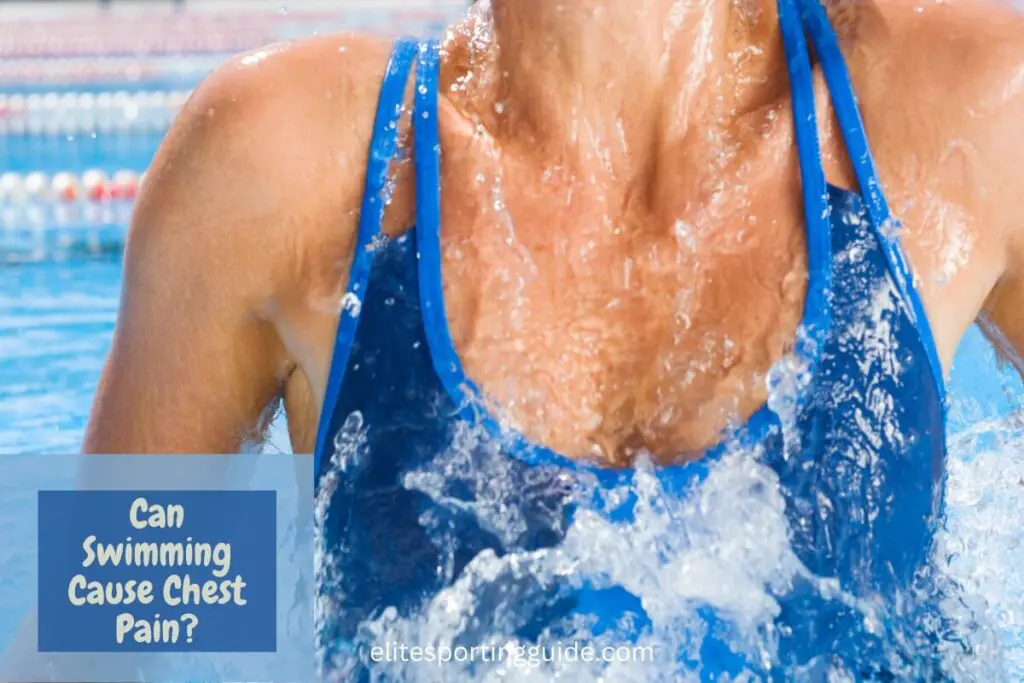In the pursuit of a healthy and active lifestyle, swimming is often hailed as an excellent choice for exercise.
However, like any physical activity, swimming is not without its potential risks and discomforts. One concern that occasionally arises is whether swimming can cause chest pain.
While it is not a common occurrence, chest pain during or after swimming can be alarming and may have various underlying causes.
In this article, we will investigate the factors that can lead to chest discomfort while swimming, the potential causes, and the importance of seeking medical evaluation to ensure safety and peace of mind for swimmers of all levels.
Can Swimming Cause Chest Pain?
Swimming can potentially cause chest pain in some individuals, although it’s not common. Chest pain during or after swimming may be due to various factors, including strenuous exercise, cold water, or underlying medical conditions like costochondritis or angina.
Understanding the Physical Demands of Swimming
Understanding the physical demands of swimming is essential for anyone looking to engage in this popular and effective form of exercise.
Swimming is a full-body workout that places unique demands on the cardiovascular, muscular, and respiratory systems.
Cardiovascular fitness plays a significant role as the heart pumps blood efficiently to deliver oxygen to working muscles.
This sustained effort not only strengthens the heart but also improves circulation, ultimately enhancing overall cardiovascular health.
Furthermore, the rhythmic nature of swimming provides an excellent opportunity to develop endurance, making it an ideal choice for individuals seeking to boost their stamina and aerobic capacity.
In addition to cardiovascular benefits, swimming heavily engages various muscle groups throughout the body.
From the arms and legs to the core and back muscles, every stroke involves a coordinated effort, resulting in improved strength and muscular endurance.
The water’s resistance provides a low-impact environment for muscle development, reducing the risk of joint strain and injury compared to high-impact activities.
Proper breathing techniques in swimming are crucial to accommodate the challenges of being in the water, enhancing respiratory fitness over time.
As swimmers adapt to these physical demands, they not only become more proficient in the sport but also reap the rewards of improved overall physical conditioning.
Understanding these aspects of swimming sets the foundation for a safe and effective aquatic exercise regimen.
Potential Causes of Chest Pain While Swimming

Here are some potential causes of chest pain while swimming:
1. Muscle Fatigue and Soreness: Intense swimming sessions, especially if you are not adequately conditioned, can lead to muscle fatigue and soreness in the chest and upper body.
2. Costochondritis: Costochondritis is the inflammation of the cartilage that connects your ribs to the breastbone.
It can cause sharp chest pain, and swimming motions may exacerbate this condition.
3. Cold Water Shock: Sudden exposure to cold water can cause involuntary gasping and rapid breathing, potentially leading to chest discomfort or pain.
4. Shallow Breathing: Improper breathing techniques while swimming, such as shallow breathing or holding one’s breath, can lead to oxygen deprivation and chest tightness.
5. Exertional Angina: Individuals with coronary artery disease may experience chest pain (angina) during strenuous activities like swimming due to reduced blood flow to the heart muscle.
6. Hyperventilation: Over-breathing, which can occur when someone is anxious or not accustomed to swimming, may lead to chest pain and lightheadedness.
7. Dehydration and Electrolyte Imbalance: Inadequate hydration and electrolyte imbalances can contribute to muscle cramps, including those in the chest area.
8. Preexisting Medical Conditions: People with underlying heart or respiratory conditions may experience chest pain while swimming due to the added strain on these systems.
9. Inhaling Water: Accidentally inhaling water while swimming can lead to coughing fits and chest discomfort.
10. Environmental Factors: Poor air quality, high humidity, or exposure to allergens in an indoor pool environment can trigger respiratory issues and chest discomfort.
Preventing Chest Pain During Swimming
Preventing chest pain during swimming involves several strategies to ensure a safe and enjoyable aquatic experience. Here are some steps you can take:
1. Warm-Up and Cool-Down:
Always start your swimming session with a proper warm-up.
Gentle swimming or light stretching exercises can help prepare your muscles and cardiovascular system for more intense activity.
After your swim, engage in a cool-down routine to gradually reduce your heart rate and prevent muscle cramps or stiffness.
2. Proper Breathing and Stroke Technique:
Focus on your breathing technique while swimming. Inhale and exhale rhythmically with each stroke to ensure a steady oxygen supply and reduce the risk of hyperventilation.
Work on refining your stroke technique. Efficient strokes require less effort and are less likely to strain your chest muscles.
3. Gradual Progression:
If you are relatively new to swimming or increasing the intensity of your workouts, progress gradually.
Avoid overexertion, as this can lead to muscle fatigue and chest discomfort.
4. Stay Hydrated:
Proper hydration is essential for muscle function and overall well-being. Drink water before, during, and after your swim to prevent dehydration and muscle cramps.
5. Monitor Intensity:
Be mindful of the intensity of your swim sessions. If you feel chest pain or discomfort, slow down or take a break. Pushing through pain is not advisable.
6. Recognize Warning Signs:
Familiarize yourself with the difference between normal muscle fatigue and concerning chest pain.
If the pain is sharp, persistent, or accompanied by other symptoms like dizziness or shortness of breath, stop swimming immediately and seek medical attention.
7. Know Your Limits:
Listen to your body. If you have underlying medical conditions or a history of chest pain, consult with a healthcare professional before starting a swimming program.
They can provide guidance on safe exercise.
8. Cold Water Precautions:
In cold water, acclimate slowly and wear a wetsuit if necessary to minimize the shock to your body. Sudden exposure to cold water can lead to chest discomfort and even hypothermia.
9. Proper Swimming Environment:
Choose swimming environments with good air quality and appropriate water temperature. Avoid swimming in areas with potential allergens if you have respiratory issues.
10. Learn Lifesaving Skills:
Being trained in basic water safety and rescue techniques can provide confidence and security while swimming.
Post you may like: Can Swimming Cause Headaches?
When to Seek Medical Attention

Knowing when to seek medical attention for chest pain during or after swimming is crucial for your safety and well-being.
Here are some guidelines to help you determine when to seek medical help:
1. Severe or Persistent Chest Pain: If you experience severe, sharp, or persistent chest pain that does not improve with rest or changes in activity, seek medical attention immediately.
This could be a sign of a heart-related issue that needs immediate evaluation.
2. Pain Accompanied by Other Symptoms: If chest pain is accompanied by symptoms such as shortness of breath, dizziness, nausea, vomiting, cold sweats, or a feeling of impending doom, it could indicate a heart attack. Call for emergency medical assistance (911 in the United States) without delay.
3. Pain Radiating to Other Areas: Chest pain that radiates to the neck, jaw, shoulders, arms (especially the left arm), or back can be a sign of a heart problem and should prompt immediate medical attention.
4. Breathing Difficulty: If you have difficulty breathing or experience wheezing or a feeling of tightness in your chest while swimming, stop swimming and seek medical help, especially if you have a history of respiratory issues.
5. Chest Pain with Known Heart Conditions: If you have a history of heart disease, angina, or other heart-related conditions, and you experience chest pain while swimming, it’s essential to contact your healthcare provider for guidance, even if the pain seems mild.
6. Pain After Swimming: If you experience chest pain after swimming, and it lingers or worsens, do not ignore it. Consult a healthcare professional to determine the cause and receive appropriate evaluation and treatment.
7. Chest Pain in Individuals at Risk: If you are at an increased risk of heart disease due to factors such as age, family history, smoking, high blood pressure, or diabetes, any chest pain during exercise, including swimming, should be taken seriously.
8. Unexplained Chest Pain: If you have chest pain during or after swimming, and you are unsure about the cause, it’s always better to err on the side of caution and seek medical evaluation to rule out any underlying issues.
Remember that early intervention can be critical in addressing heart-related problems, so never hesitate to seek medical attention if you are uncertain about the cause of your chest pain or if it is accompanied by concerning symptoms.
Your health and safety should always be the top priority.
Post you may be interested in: Can Swimming Be Bad For Your Back?
Conclusion
Swimming is an excellent form of exercise and recreation for many individuals, offering numerous health benefits and a refreshing way to stay active.
However, it’s essential to be aware of the potential risks, particularly chest pain, which, though relatively rare, can occur during or after swimming.
Understanding the physical demands of swimming, recognizing potential causes of chest pain, and taking preventive measures such as proper warm-up, hydration, and monitoring your body’s signals can help reduce the likelihood of experiencing discomfort in the chest while swimming.
Importantly, knowing when to seek medical attention is paramount.
Any severe or persistent chest pain, especially when accompanied by other symptoms like shortness of breath or radiating pain, should never be ignored, as it may signal a serious heart-related issue that requires immediate evaluation by a healthcare professional.
By staying informed, practicing safe swimming habits, and heeding warning signs, individuals can continue to enjoy the many benefits of swimming while minimizing the potential risks associated with chest pain.
Ultimately, swimming can be a safe and fulfilling activity for people of all ages and fitness levels when approached with awareness, caution, and a commitment to one’s health and well-being.



